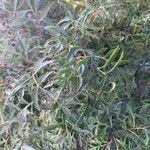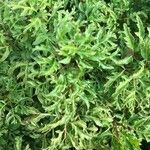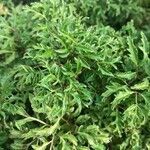Glabrous shrub or, small tree, up to 5 m, with branches bearing spirally arranged leaves towards their ends. Leaves tripinnate, variable in size to c. 75 cm long; petiole up to c. 25 cm, with a sheathing base to 5 cm long; pinnae to c. 25 cm long; leaflets shortly petiolate, very variable in shape and size, oblong or linear-lanceolate, or 1-12 by 0.5-4 cm, more or less deeply serrate or lobed, or irregularly pinnatisect, apex attenuate, acuminate or rounded, base cuneate, truncate or subcordate, midrib and lateral veins evident. Inflorescence a diffuse panicle; primary axis up to c. 60 cm with secondary branches mostly in verticils at intervals along its length; secondary branches up to 30 cm bearing umbellules in an irregularly branched system towards their extremities; umbellules with 12-20 flowers on pedicels c. 3 mm long. Calyx a minute rim. Petals 5, 2 mm long. Stamens 5. Ovary turbinate, c. 1 mm high, 2-3(-4)-celled; styles at first erect, later spreading. Fruit subglobose, fleshy, c. 5 mm ø when dry.
A tall shrub. It grows 3-5 m high and spreads 2-3 m wide. The branches are spreading. The leaves are clustered near the tips. The leaves are divided 3 times. They are 75 cm long. They sheath the stem at the base. The leaflet stalks are 25 cm long and the leaflets are 1-12 cm long by 0.5-4 cm wide. They vary in shape. They can be lobed or have teeth. The flowers are 0.5 cm across and in a spreading group 60 cm long. The fruit are 0.5 cm across. They are fleshy. The plant varies a lot and it can be like Polyscias cumingiana.



